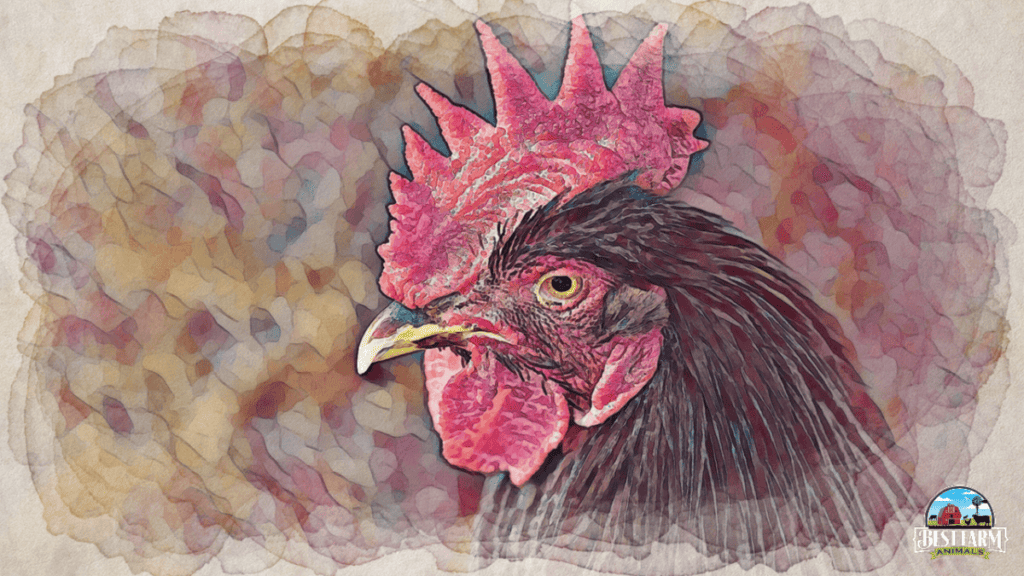Table of Contents
Rhode Island Chickens- An Egg Factory
Rhode Island Red chickens are known for their excellent egg-laying abilities and hardiness. They are one of our top 8 chicken breeds that lay over 300 eggs a year!
Rhode Island Reds grow quickly, with chicks hatching at around 21 days and reaching maturity at around 5-6 months of age. They are a medium to heavy breed with a solid, muscular build. The wingspan of a Rhode Island Red can vary, but it generally ranges from 28 to 30 inches.
One of the distinct characteristics of Rhode Island Reds is their hardiness and adaptability to various environments. They are primarily known for their egg-laying abilities. On average, a healthy Rhode Island Red hen can lay around 180-200 eggs annually, which translates to about two or three eggs per week. Rhode Island Red eggs are brown in color and typically have a size between 52 and 55 grams.
About Rhode Island Red Chickens
Rhode Island Reds are one of the most successful chicken breeds in the world. They are super popular.
In 1854, a sea captain, William Tripp, bred a Malay chicken with his own chickens. He noticed that the offspring produced more eggs. He enlisted the help of his friend, John Macomber, and breeding began in earnest.
Eventually, Isaac Wilbour bought some of the new breed and continued to refine it. As a result, Wilbour usually gets the credit of the Rhode Island Red.
They were bred as a dual purpose bird. They are the official bird of Rhode Island and have two statues in the state erected to the breed.

Rhode Island Red’s Physical Traits
The body of a Rhode Island Red Chicken looks like a long brick. The birds are red, although it can vary from a brilliant red to a dark vibrant red. They can have a little black on their tail feathering.
They have hard feathers with red wattles, comb and ear lobes. Their feet and legs are yellow with some darker coloring down the shanks.
Rhode Island Red chickens, single comb, were admitted to the American Poultry Association in 1904. Rose comb was accepted in 1905. Since that time, the color of their red feathers has changed.
They are considered a heritage chicken. Rhode Island Reds usually live 4-8 years with an average lifespan of 6 years.. The older breed may have a longer lifespan depending on genetics.
Reasons To Raise Rhode Island Red Chickens
Rhode Island Red chickens were first bred as a dual purpose bird. Since the breed was created, the breed has split between a heritage version and a newer commercial breed. The heritage RI Reds have a good table quality and are also used for show birds. The commercial variety isn’t often used for meat, although it may still be a good meat bird. Instead, they are usually used for their superior egg-laying abilities.
Roosters grow to 8.5 lbs (3.85 kgs) and hens grow to 6.5 lbs (2.9 kgs).
Caring For Your Rhode Island Red Chickens
Rhode Island Red chickens may be the easiest chickens to care for. They’re laid-back and adaptable in almost any situation.
Plus, they are active foragers. They also do well in confinement. They are super adaptable and will thrive in any climate. They do well in very cold climates and very hot climates.
RI Reds are a very laid back bird that doesn’t stress out. They tolerate challenges very well. They can handle adversity and adjust to a wider variety of food and living situations.
Rhode Island Reds are a great bird for first-time chicken owners because they are assertive, but won’t be obnoxious. They also won’t struggle with many of the mistakes a first-time poultry raiser can make.
They are friendly and can be tamed.
The heritage breed is on watch status, but the modern version is common.
| Climate | Personality | Use | Size | Eggs/ Yr | Brooder | Forages |
| Any Climate | Adaptable Friendly | Eggs & Meat | M: 8.5 lbs
F: 6.5 lbs | 200-300 | No | Yes |
- Great Egg Layer
- Super adaptable in any situation
- Very laid back and friendly
My Favorite Chicken and Duck Supplies
This list contains affiliate products. Affiliate products do not cost more but helps to support BestFarmAnimals and our goal to provide farm animal owners with accurate and helpful information.
Manna Pro Oyster Shell keeps eggs strong. Before I gave my chickens oyster shell, I had the oddest eggs, many with weak and irregular shells. Now, I don’t have an issue.
Layer Feed by Manna Pro. I like pellets rather than crumbles as my chickens eat them better and less gets wasted or scavenged by rodents. A good layer feed makes the difference in hens laying many more eggs.
My chickens love this mealworm treat, which gives added protein, something that’s great during molting and winter months.
There are many ways to feed and water your chickens. I like this food and water setup the best because it reduces waste, saves me time feeding and watering, and keeps the food fresh longer. Except, in the winter, I use a heated waterer. The only problem is the heated waterers need to be replaced every few years.
I love this chicken veggie hanger. It makes it easy to give your chickens produce from the garden and keep them occupied in the winter with a fresh head of lettuce.
These chicken toys are a hoot! They will help curb bullying and keep your chickens active, especially in the winter when hens tend to get more lethargic.

